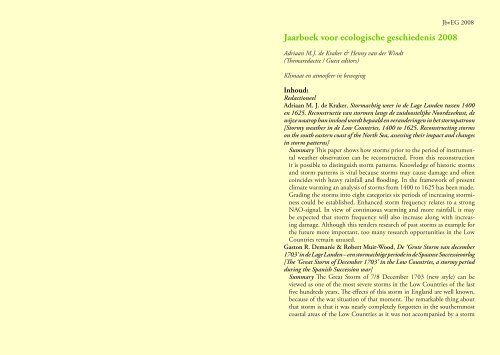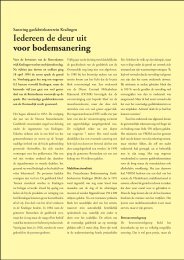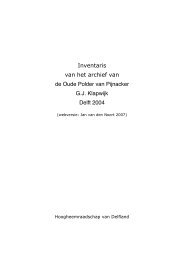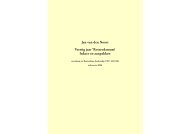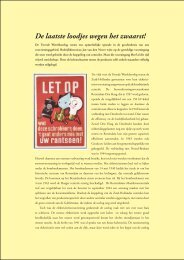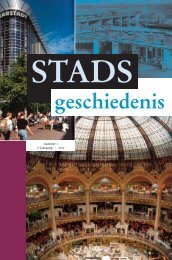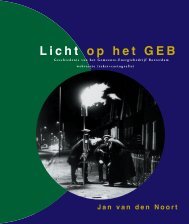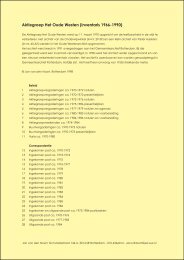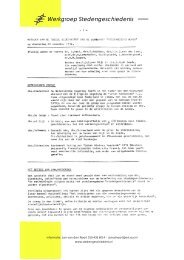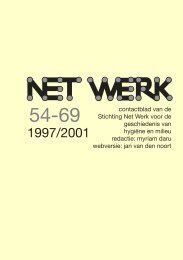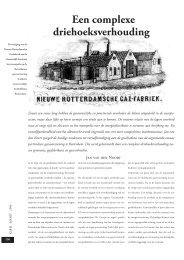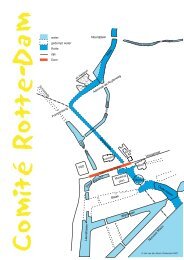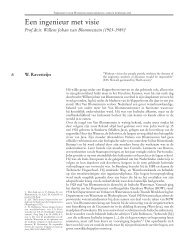Jaarboek voor ecologische geschiedenis 1998, Summary
Jaarboek voor ecologische geschiedenis 1998, Summary
Jaarboek voor ecologische geschiedenis 1998, Summary
Create successful ePaper yourself
Turn your PDF publications into a flip-book with our unique Google optimized e-Paper software.
<strong>Jaarboek</strong> <strong>voor</strong> <strong>ecologische</strong> <strong>geschiedenis</strong> 2008<br />
Adriaan M.J. de Kraker & Henny van der Windt<br />
(Themaredactie / Guest editors)<br />
Klimaat en atmosfeer in beweging<br />
JbvEG 2008<br />
Inhoud:<br />
Redactioneel<br />
Adriaan M. J. de Kraker, Stormachtig weer in de Lage Landen tussen 1400<br />
en 1625. Reconstructie van stormen langs de zuidoostelijke Noordzeekust, de<br />
wijze waarop hun invloed wordt bepaald en veranderingen in het stormpatroon<br />
[Stormy weather in de Low Countries, 1400 to 1625. Reconstructing storms<br />
on the south eastern coast of the North Sea, assessing their impact and changes<br />
in storm patterns]<br />
<strong>Summary</strong> This paper shows how storms prior to the period of instrumental<br />
weather observation can be reconstructed. From this reconstruction<br />
it is possible to distinguish storm patterns. Knowledge of historic storms<br />
and storm patterns is vital because storms may cause damage and often<br />
coincides with heavy rainfall and flooding. In the framework of present<br />
climate warming an analysis of storms from 1400 to 1625 has been made.<br />
Grading the storms into eight categories six periods of increasing storminess<br />
could be established. Enhanced storm frequency relates to a strong<br />
NAO-signal. In view of continuous warming and more rainfall, it may<br />
be expected that storm frequency will also increase along with increasing<br />
damage. Although this renders research of past storms as example for<br />
the future more important, too many research opportunities in the Low<br />
Countries remain unused.<br />
Gaston R. Demarée & Robert Muir-Wood, De ‘Grote Storm van december<br />
1703’ in de Lage Landen – een stormachtige periode in de Spaanse Successieoorlog<br />
[The ‘Great Storm of December 1703’ in the Low Countries, a stormy period<br />
during the Spanish Succession war]<br />
<strong>Summary</strong> The Great Storm of 7/8 December 1703 (new style) can be<br />
viewed as one of the most severe storms in the Low Countries of the last<br />
five hundreds years. The effects of this storm in England are well known,<br />
because of the war situation of that moment. The remarkable thing about<br />
that storm is that it was nearly completely forgotten in the southernmost<br />
coastal areas of the Low Countries as it was not accompanied by a storm
JbvEG 2008<br />
surge (what did occur so in the coastal area from the Channel to Northern<br />
Germany and Jutland and also during the storm of 1717). The authors<br />
provide in this paper an analysis of the storm in which attention is given<br />
to the origin, the force of the storm and its further development. Next to<br />
it, contemporaneous descriptions on the passage of the storm in the Low<br />
Countries are given focusing on the damage occurred.<br />
Joop Oude Lohuis, De rol van wetenschappelijke gegevens in het klimaatdebat,<br />
de discussie over de ‘hockeystick’ als grafische weergave van een historische<br />
reconstructie van het klimaat [The role of scientific data in the climate debate,<br />
the discussion on the ‘hockeystick’ as a graphical representation of a historical<br />
climate reconstruction]<br />
<strong>Summary</strong> Scientific data play a substantial role in the societal and political<br />
discussions on climate policy. An important example are the data with regard<br />
to the so-called ‘hockeystick’, a graphical representation of a reconstruction of<br />
the climate developments during the last millennium. Such reconstructions<br />
are far from easy and are always surrounded with uncertainties. However,<br />
these kinds of reconstructions are the basis for predictions of the global<br />
effects of climate change in the future. For that reason, science should be as<br />
transparent as possible in its efforts to calculate the risks and to formulate its<br />
societal recommendations. In this article the focus is on the history of the<br />
climate problem, the Intergovernmental Panel on Climate Change (IPCC)<br />
and Dutch climate policy. The actual societal discussions on the climate<br />
issues and the interactions with scientific developments will be illustrated<br />
by the ‘hockeystick’.<br />
Ed Buijsman, Het chemische neerslagonderzoek in Nederland, een kleine<br />
<strong>geschiedenis</strong> [Chemical deposition research in the Netherlands, a short<br />
history]<br />
<strong>Summary</strong> Precipitation: rain, snow, hail − ultimately, all of it is water.<br />
As early as in the 17th century, however, some researchers expected to<br />
discover more than just water. Throughout the centuries and for various<br />
reasons, scientists would be preoccupied with the chemical composition of<br />
precipitation. Research in the Netherlands was mostly based on previous<br />
experiences in other countries. Dutch researchers played a modest role in<br />
this field, apart from a period around 1985, when they worked on acid rain<br />
at an international level. At that time, they did contribute to the solution of<br />
the many methodological problems that surrounded this area of research.<br />
This article provides a brief summary of Dutch research work, starting at<br />
the time of Van Leeuwenhoek, in 1702, up to the 1990s.<br />
JbvEG 2008<br />
Hein-Anton van der Heijden, Zandzakken, notenbomen en een taart.<br />
Nederlandse sociale bewegingen en mondiale klimaatverandering [Sandbags,<br />
walnut trees and a cake. Dutch social movements and global climate<br />
change]<br />
<strong>Summary</strong> Dutch environmental and conservation groups have contributed<br />
significantly to politicising climate change. Analogous to the diversity of<br />
the movement – from mobilising organisations like Friends of the Earth,<br />
via conservation groups at the provincial level, to radical groups like the<br />
Greenwash Guerilla’s – a plurality of problem definitions, solution strategies<br />
and action models has emerged. Apart from lobbying, the action repertoire<br />
varies from building a sandbags dike around the site of the 2000 Climate<br />
Summit in The Hague, via the planting of walnut trees in order to raise<br />
consciousness about the relationship between deforestation and climate<br />
change, to throwing a cake to the American delegation leader at the Climate<br />
Summit in The Hague. However, due to the specific Dutch political<br />
opportunity structure, problem definitions and solution strategies are not<br />
that radical: ecological modernisation and cooperation with government<br />
and business.<br />
Jos Dekker, De dynamische opstelling van het Landbouwschap ten aanzien<br />
van het milieu 1948-1972 [The dynamic position regarding the environment<br />
of the Agricultural Board 1948-1972]<br />
<strong>Summary</strong> The Dutch Society for Agriculture and the Agricultural Board have<br />
dealt with poblems of nature, landscape and the environment between 1948<br />
and 1972 more than expected. Their position regarding the environment<br />
developed in a complex and dynamic way. There was a regular consultation<br />
with the Contact Committee for the Conservation of Nature and Landscape.<br />
The cooperation had a pragmatic character. Although there were options for<br />
further co-operation, co-operation remained limited. This was the result of<br />
the structurally different developments of agriculture and nature protection.<br />
The agricultural neocorporatism model was another factor, because it was<br />
closed for outsiders like conservationists.<br />
Recensies<br />
English Abstracts


